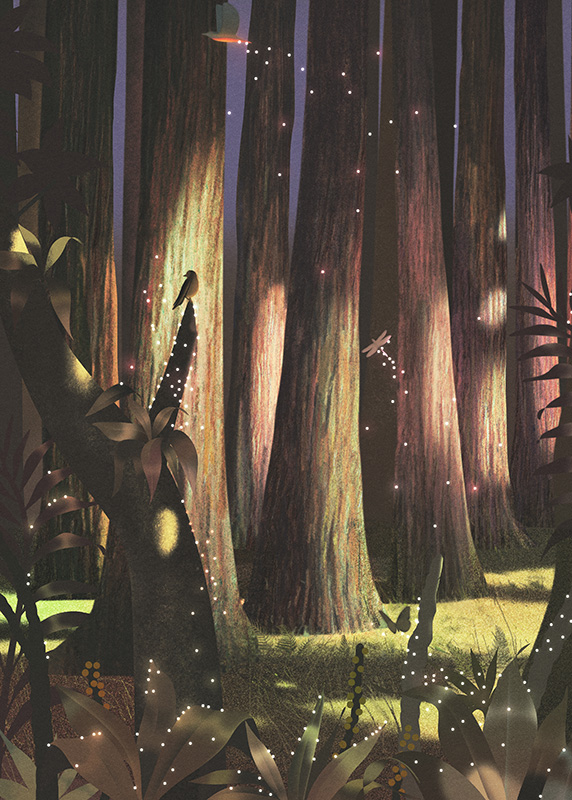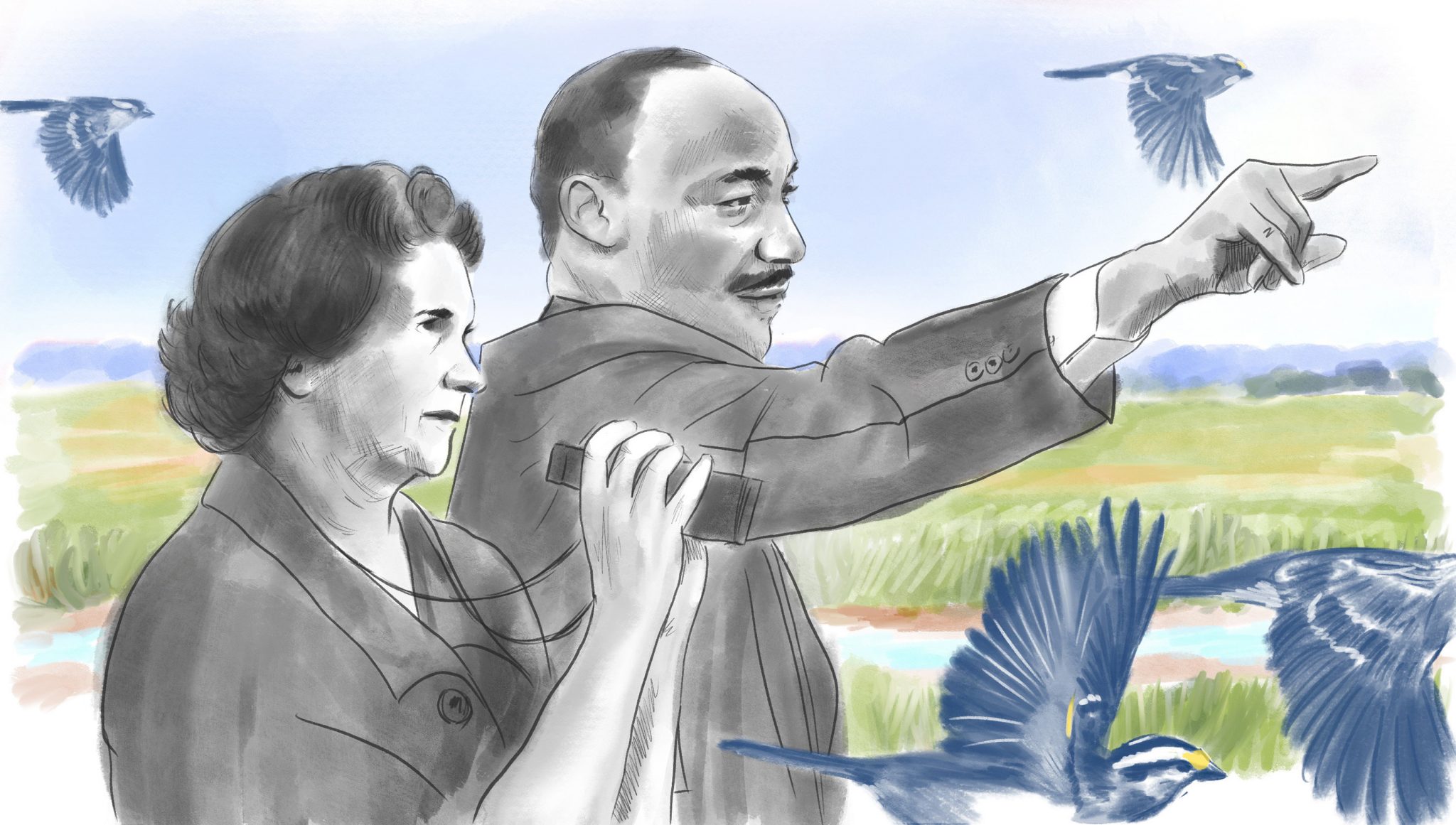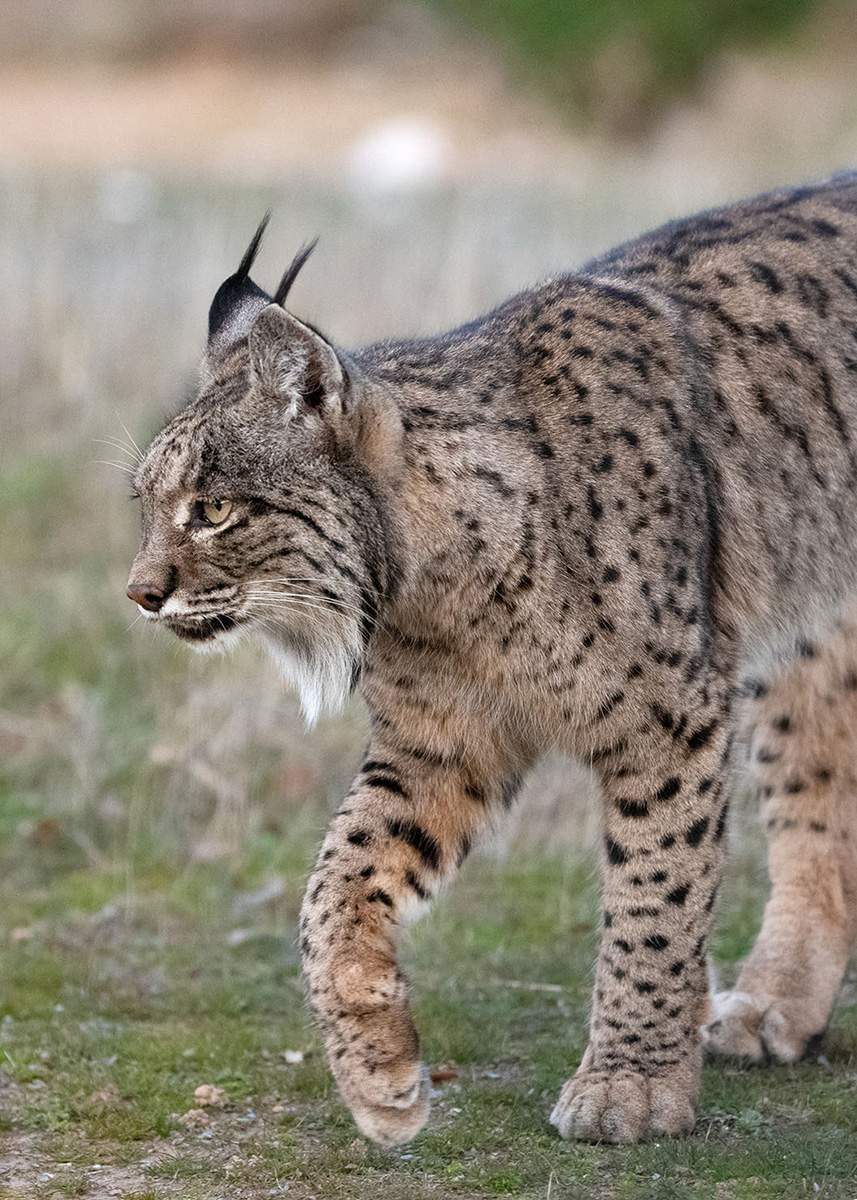
J. Drew Lanham is a birder, naturalist, and hunter-conservationist. He is the author of The Home Place: Memoirs of a Colored Man’s Love Affair with Nature, which received the Reed Award from the Southern Environmental Law Center and the Southern Book Prize, and was a finalist for the John Burroughs Medal. His essays and poetry can be found in Orion, Audubon, Flycatcher, and Wilderness, and in the anthologies The Colors of Nature, State of the Heart, Bartram’s Living Legacy, and Carolina Writers at Home. He is an Alumni Distinguished Professor of Wildlife Ecology and Master Teacher at Clemson University.
Gabriella Trujillo is an illustrator from Southern Colorado. She received a BFA in painting from the University of Colorado and studied at Università degli Studi della Tuscia in Viterbo, Italy. Some of her notable clients include NPR, The Atlantic, and Southwest Contemporary. She currently lives in Northern New Mexico.
What if Dr. Martin Luther King Jr. and Rachel Carson had met? Imagining an exchange in the year 1964, as the civil rights and environmental movements were forging parallel and increasingly urgent paths into American culture, J. Drew Lanham explores the power and necessity of convergence.
January 6, 1964
Rachel Carson
11701 Berwick Road
Silver Spring, MD 20904
Dear Miss Carson,
Rachel, if I might? Hoping you are well in these turbulent times. I am fine but feel now pressed to do even more after this last attempt at silencing me came so close.
I became aware of you, Miss Carson, hearing your voice ring strong through the articles I’ve come across in various magazines. Although I am not a bird-watcher or naturalist, your passion for doing right by God’s creation—birds and humanity both—strikes me as righteous in every sense of the word. Considering how grave is the need to enlarge the just message of charity and care to every living soul in these urgent times we find ourselves in, I felt compelled to reach out.
I’m inquiring to find out if you might be willing to travel south to join me at a wondrous place deep down in the South Carolina Low Country. This place, the Penn Center, is in the heart of history both bitter and sweet. Bitter because the Low Country was at the center of so much pain and misery for the Gullah people—those closest in heritage and blood to West Africa, who were kidnapped and enslaved for the purpose of growing this nation, by cotton bale and rice crop, into the power that it has become. The sweetness lies in the fact that this place where so much pain was enacted became, early in the Civil War, a kind of freedmen’s refuge, as liberty came earliest where in many ways bondage had been harshest. This Penn Center, which developed into a novel community of Negro self-sufficiency with schools, farming, and the infrastructure necessary for those loosed from shackles to thrive unfettered, was radical in origin, and I believe it will become a great progressive reservoir for our thinking about how best to free all people—Black, White, Brown, Red, and otherwise—and thus hold this nation to the promises it has made. It is in a far corner of an expanse of wildness—salt marsh, forest, and sea—that makes it mostly inaccessible to all but the native Gullah people and the few white folks living, fishing, or hunting there. In that way, it will be a safe place for respite and reflection. I can promise solitude and little interference from the public and press.
I’m thinking, Miss Carson, that we might convene in Charleston or Savannah (whichever is most convenient to you but also draws the least attention from reporters and those set against us) and then drive out to the Penn Center on the marsh. I know you will appreciate the vistas of so much wild on the commute. I imagine there will be birds in abundance to hold your attention. We can talk en route. There is a great chance that a young man named John Lewis from Alabama will be there. He preaches to chickens, I hear, and so the two of you will have feathers in common. A couple of the team members, Ralph or Jesse, might join us on the marsh walks, but they’ve already complained of the mosquitoes they’ll encounter and so will likely stay behind. As I’ve said, I’m no bird-watcher, but I’m hoping that if there are sparrows to be observed, perhaps you might watch them, too, and be able to even tell me what—or who—they are. If God sees fit to watch them, perhaps I should pay more attention too.
I’m hoping that we might congenially discuss what I trust will be our shared mission to make this world better for all beings—for every living thing. Our singing birds. Our fight for civil rights. I know that you may have had your fill of all things political. I’m asking not that you commit to marches or more congressional hearings but, rather, to brainstorm with me on how to expand this movement and enlarge the one that I believe you’ve set fire to. Thinking on it, I find it hard to see how one can love the earth but not fellow human beings. And also, it seems incongruous that one could love humanity and exact sins of degradation against nature. I think we’d be closer to getting this act passed with more pressure and some political will, which might happen if we could stretch the concept of civil rights to the very air we breathe—the air we share with your beloved birds.
After so much confinement, by the iron bars of Birmingham and the clutches of oppression that seem ever present and everywhere, I believe the salt marsh will offer opportunities for reflection that might liberate me to breathe more freely and thus think more deeply. I’ve heard that you, too, are best able to think beyond four walls in the wells of creation. I’m convinced that a bit of time together might fortify us both. I know your recent book will move mountains to make this world a better place. I did, in fact, read the words you wrote in The New Yorker and felt a sense of urgency in expanding the mission to one that might embrace environmental concerns. I am not sure you are aware of this, but our Negro communities suffer mightily from the uneven distribution of clean water and air. Our neighborhoods bear the brunt of industrial smokestacks pouring choking air into our lungs. Our farmers suffer chronic land loss and financial deprivation at the hands of the government. I ask, how can free men and women of any hue realize the full potential of their beings when so encumbered as to not have potable water or breathable air? How can we sustain ourselves dispossessed of the soil we’ve already paid for in bondaged blood, enslaved sweat, and tears wrought by terror? I cannot release these thoughts from the current work and would like to converse with you face-to-face in the hope that we might see eye to eye on these things.
I’ve not visited the island yet, but I have it on good word that spring is wonderfully not silent on St. Helena and no alarm clocks are required for awakening, as the birdsong will do the work of rousing us. I believe a bit of a time-out might do us both some good. In bearing witness to freedom as it exhibits itself in wildness, there are lessons, perhaps, to be gained. Whether wings and feathers or hands and fingers, we share the same air, same water, same soil, same earth. We share, regardless of color or condition of skin or plumage, the same fate. I believe a gathering might empower the moment in mighty ways. I’m looking forward to hearing from you and thank you in advance for taking the time to consider my request.
In hopeful preparation of an affirmative response, I will have those in charge secure lodging for you. I’ll also have them tell the birds that a great friend is coming to visit them.
Sincerely and with great regard,
Martin Luther King, Jr.
***
February 2, 1964
Rev. Martin Luther King
234 Sunset Ave. NW
Atlanta, GA 30314
Dear Reverend King,
Or do you prefer Doctor? I want to make sure I proffer all possible respect, as I very much admire what you have accomplished. First of all, thank you for the gracious note. I take great pride in knowing that it came from one so esteemed. Your people have been greatly aggrieved for the entire history of our nation, and you seem now in a position to address those grievances.
I can say that, although a white woman and living in a world far away from yours, I may have some understanding of the grievances derived from being the target of bias because one is different, and of hatefulness because one speaks out for right in the midst of wrong. For some time I have been accused of being different in a certain way and, by those accusations, of being unworthy to credibly voice the crimes against nature. I reveal these transgressions only as testament of some sympathy with your people’s plight. No, I have not been denied the essential rights of humanity, and I understand the privilege that my skin renders, but I think we have some common ground, as the men in power in our nation have a way of suppressing freedom, which we must all recognize as untenable.
As I advocate for the love and protection of all nature and you for the love and protection of all humanity, we have indeed trod parallel paths on missions whose trajectories need to converge. The birds, threatened by poisons, sing for all of us—Negro and white. The civil rights that your movement peacefully fights for are rights not just for some but for us all. We share, no matter our color, the same air, same water, same soil, same earth, same fate. That feathered beings share these elements of existence with us is, again, a common thread in our work. You must know the saying, and the song, “God’s eye is on the sparrow.” That these birds foretell all of our futures, like “canaries in a coal mine,” is a vital connection around which we might join the force of our words.
Here in Silver Spring I more often hear of the struggles than witness them. Our neighborhood is a rather white one, and in my frequent isolation I feel out of touch in ways. I would hope that my writing might reach beyond those who look like me and make a greater impact in this world.
And so, yes, Martin, if I may, I would very much like to visit your place on the Beaufort marsh. I’ve spent a little time in South Carolina but am not so familiar with it. Of what I know, it has always seemed a beautiful, natural place but one wrought in conflict when it comes to racial equality. That you find peace enough in this Penn Center to travel there makes me curious to see it. As you may know, I spend time in Maine by the sea and in the lovely tidal pools with sea stars, urchins, and the wondrous creatures trapped therein at low tide. I look very much forward to seeing what your tide brings in to a muddy southern marsh.
And yes, I happen to love sparrows. We will watch and identify them together.
Regards,
Rachel
PS: It is not well known, but my health is compromised, so I may have to limit my visit to a day or two at most. Time seems ever of the essence. You, unfortunately, have had to dodge danger from external forces more acutely. My assassin lies within. Deadly in a different way, and likely fatal in its persistence. Hoping we both survive these threats to meet and blend missions. I, too, feel a certain urgency. By the way, do you own a pair of field glasses (binoculars)? I will pack an extra pair and bring my field guide as well, just in case. I will see you in Beaufort—and hopefully on a good tide.
***
Convergence is a force of confluence.
Among living things, convergence often happens where beings gather towards common purpose. Flocks of birds gather in migratory urgency to cross abysmal gulfs and swaths of land, guided by stars and instinct. A mixed flight of neotropical migrants makes its way together, individuals of many species loosely linked but on the same path. Convergence gains purpose with this urgency. Seasonal flux—the dynamics of light and dark, the abundance of resources or their dearth—compels gathering and action to find better than the status quo can offer. Convergences in nature evolve over millennia, but they can also occur without a moment’s notice seemingly by chance, luck, or whim. When urgency meets convergence, purpose can be compounded.
Convergence and urgency must also be a part of human social movements. In this age of siloing, dismantling by discrimination, and imagined conspiracies disrupting truth, I’m imagining a fiction that could have been true. I’m imagining a meeting of Black and White that never happened. I’m imagining an exchange of mutual respect and a potential for traversing common ground that didn’t occur.
I wonder, if certain strangers had met, what would their coming together have meant? Circumstances dictate chance. Chance fosters possibilities. Could a conversation create its own momentum? Could separate suddenly become conglomerate with a greater mission?
The civil rights and environmental movements shared a decade of intense evolution, parallel yet separate and unequal. The struggle for human rights—free-flowing equality and enfranchisement framed by peaceful protests to counter an apartheid state of fire hoses, police dogs, lynchings, and assassinations—dwarfed the quieter trickling subtleties of protecting wilderness, banning pesticides, and saving endangered species. While the marching, sit-ins, and protests were happening in the streets and at lunch counters, where predominantly Black activists were clubbed and spat upon, despised like blackbirds for simply being who they are, the environmental movement came mostly quiet as a snowy egret—and just as white. Dogs weren’t loosed on middle-class suburbanites carrying “No Nukes” signs. The rights of nature were wrestled over through hearings, discussions, slander, and the occasional argument. But life was also at stake. Pesticide toxins like DDT were biomagnifying up the food chain—all for the illusion of a better life. Nuclear concerns were revealing that we were threatened by more than just atomic bombs and mushroom clouds. What is wildness worth? And clean air? Clean water? Save planet earth.
The course of social justice and care of nature ran parallel in time across a decade that saw “Colored” and “Negro” evolve to Black Power. The anti-war and civil rights movements merged over the common cause of peace and nonviolence, each empowering the other; and poverty-fighting efforts found easy allies amid the fight for voting rights. Voting and civil rights were codified. On the other side, immense swaths of open spaces were being preserved. Deadly insecticides were finally outlawed.
The two movements would’ve seemed disjunct at first glance: Black people demanding equity, justice, and enfranchisement as full citizens in peaceful protest; white people demanding wilderness recognition, clean air, and protection for dwindling species in hearings and op-eds. But looking deeper, both movements, then and now, contain a prevailing desire for a better world built on sustaining good for all. Social justice and the movement to steward and protect nature rise from a similar foundation: a belief in building a better future by being selfless, by sharing and supporting the greater good through sacrifice, by planting the seeds of trees under whose shade you may never sit. These movements share common ground—a clear moral code that (if uncorrupted by ego, profiteering, and power plays) offers a path forward that stretches toward a common cause. King’s “long arc bending toward justice” points to the radical need to sustain moral consciousness at all levels of human integration. This means, by default, care for every living thing: both humans and the environment on which they depend.
Efforts at good beget better when they converge. Yes, birds of a feather may flock together. Yet sometimes the most beautiful aggregations come not from birds of a feather flocking together, but from murmurations of difference, from diverse assemblages moving in a flowing unison that began with an individual deciding to be a part of a greater whole—to wit, the peaceful multiracial protests for racial justice in spring and summer 2020. There was, and is, power in coming together for common cause.
Sometimes the most beautiful aggregations are murmurations of difference.
I imagine here two movements converging—civil rights and environmentalism. Dr. Martin Luther King, Jr., the iconic southern Black minister who organized, led, and died on behalf of equal rights for all, stands tall as a galvanizing figure in the civil rights movement. Also a leader in the anti–Vietnam War efforts, he was turning his attention toward issues of labor and poverty when he was assassinated in Memphis in the spring of 1968. He was urgent about everything touching justice. The undrinkable, soul-drowning, racist American society he sought to clarify and clean up was a dangerous place full of obstacles to unfettered passage, and just beneath the surface were snags that could alter one’s journey to reaching full potential—or kill it full on.
Rachel Carson, a white, female biologist who morphed into a widely read nature writer and then became a gently forceful voice for banning dangerous pesticides, would not likely have stepped forward as a leader of a movement without support. Too many didn’t even see the river of woe she was calling attention to as being dysfunctional in any way. Industrialized patriarchy fought her efforts with every tool they had, including attempts at poisoning her personal wellspring. However, she persisted. Rachel’s words created a tide of congressional hearings, and appearances in print and television media, that vaulted her into a position of singular force for “cleaning up” nature. Without ever carrying a protest sign or marching a single step, she was out front, with a megaphone called Silent Spring. Rachel died of complications from cancer in the spring of 1964, less than a year after the March on Washington, MLK’s letters of incarceration, and other pivotal moments in the civil rights movement—and just two months after this imagined conversation. Her flurry of public appearances before her death seemed urgent. She clearly felt the convergence between birds and human beings.
What if Martin and Rachel had exchanged a word or two? Perhaps a meeting over coffee and pluff mud in the marsh near the Penn Center, on St. Helena Island near Beaufort, South Carolina. We know Martin sought solace there from 1964 onward. Is it too hard to imagine that, along with folks like Joan Baez and John Lewis, others might have been invited to join him in this wild and historic place?
That is the convergent imagining here. Dr. King and Ms. Carson never met. But what if they had? Let your hearts and minds flow to convergence; to mixed flocks of shorebirds, sandpipers, and plovers, urgently purposeful, moving in one grand vector toward some better place. Then imagine the same for humanity—difference-makers of variable plumage coming together under a sky of common cause with urgent tailwinds of change moving us forward. What if?









